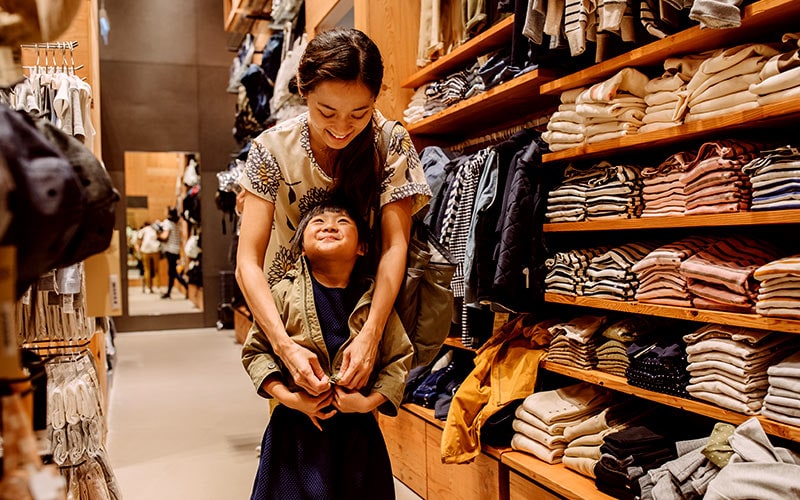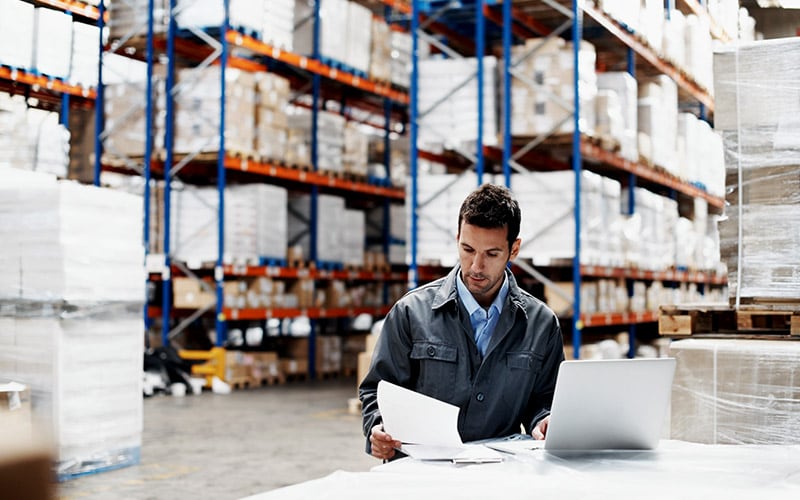Insights
- Artificial intelligence (AI) can help solve a host of issues that retail, consumer goods, and logistics industries are facing.
- However, the myriad options available regarding how and where to apply AI can be overwhelming.
- For AI to be most effective, ethical, and reliable, the human element is key.
- To realize its full benefits, AI technology needs to be designed keeping human interaction in mind, and how it can augment or accelerate human processes.

CPG, retail, and logistics companies are walking a tightrope. On one side, they are weighed down by increasing cost challenges springing from geo-political crises, a growing rate of product returns, and thefts in physical stores. On the other side, they are dealing with demand unpredictability arising from declining volumes, competitive pricing, and choosy consumers. But a helping hand is emerging, in the form of artificial intelligence (AI), which, thanks to the sudden rise of generative AI is providing a potential route to safety.
The emergence of generative AI has inspired companies to take AI seriously. Yet, there is an overwhelming array of choices in terms of how and where to apply AI applications most effectively. And companies can’t rely on AI alone. To be effective, ethical, and reliable, AI still needs humans “in the loop”. And in a market that is stretched for talent, the hardest part can be to ensure that AI enhances employees’ valuable input and productivity, rather than just mimicking it poorly.
In 2024, the decisions that businesses make about implanting and engaging with AI, will define their future success.

The screws tighten
This year, the cost of doing business will continue to be a challenge in the consumer goods sectors. Global headline inflation, while declining, is still an issue. From 9.2% in 2022, headline inflation reduced to 5.9% in 2023, and is expected to fall to 4.8% in 2024. Yet, the International Monetary Fund (IMF) forecasts that most countries will likely return to target inflation only in 2025.
Container shipping rates have fallen by 90% since 2022, and container volumes have reduced dramatically, causing revenue dips. Staffing costs also remain stubbornly high, with unemployment levels at record lows in the western world, making it harder for labor-intensive industries such as retail and logistics to fill gaps and keep costs down.
In the past year, some CPG companies passed on these costs to consumers. Yet it has not helped them recover their margins to match pre-pandemic figures. And consumers are wising up. Driven by the rising cost of living, they are more selective about purchases, favoring discount brands, or simply limiting their consumption - triggering a decline in the volume of sales in the last few quarters.
In the past year, some CPG companies passed on costs to consumers. Yet it has not helped them recover their margins to match pre-pandemic figures.
In the year ahead, the three globally connected industries of CPG, retail, and logistics, will be challenged even more to achieve growth and profitability. This will only sharpen the need to be more efficient and responsive to market shifts in order to thrive.
The promise of AI
In this climate, AI seems to be a universal cure-all for the challenges faced by so many businesses. And it has already advanced in leaps and bounds, transforming many sectors of the economy.
In particular, the sudden arrival of generative AI has sparked a boom in businesses experimenting with this transformative technology. According to IDC research, 40% of worldwide retailers and brands are in the experimentation phase of generative AI, attempting to identify relevant use cases, and 21% are already investing in the implementation of these technologies. Infosys’s Generative AI Radar 2023 North America research expects that companies in the US and Canada will invest $2.3 billion more on generative AI in 2024 than 2023. It is estimated that companies in the 11 European countries Infosys surveyed spent $1.3 billion on generative AI initiatives in 2023. It is expected to increase by 115% in 2024.
Infosys's research expects that companies in the US and Canada will invest $2.3 billion more on generative AI in 2024 than 2023.

But AI technologies have been developing and adding value to business for almost a decade, with monumental developments in capabilities related to text, image and video generation, predictive analytics, or even autonomous driving.
In 2017, Google scientists built the transformer model that laid the foundation for the large language model (LLM) that gave way to generative AI. And almost every industry is reaping the benefits, be it healthcare with patient diagnosis and treatment plan creation, banking with fraud detection and customer care, or manufacturing with inventory management and quality checks. Things are no different in CPG, retail, and logistics businesses. AI is being used for everything from customer sentiment analysis and demand forecasting, to supply chain analysis and streamlining logistics.
Where AI works best
The rapid ongoing development of AI provides many opportunities for experimentation and value creation. Yet with the fast pace of change, and the large array of options available in AI use, businesses need to think carefully about where to start, when to double down, and how to swerve the risks. Below are the four key areas we believe AI will play a big role in 2024, and beyond.
a) Source-to-sale process
The ongoing inflationary situation demands better integration and measures to cut costs all through companies’ source-to-sale cycle. By analyzing historical data, present trends, and consumer demands, AI enables them to design products that are cheaper to produce, and better at selling at high margins. It assesses the composition of the products, and suggests less-expensive ingredients or substitutes, to minimize costs. Supply chain diversification or sourcing from better places for cheaper has been a go-to business strategy but technology is helping businesses accelerate related decision-making and responsiveness.
AI helps companies optimize costs by combing through massive amounts of data and identifying inefficiencies in the system which when rectified can lead to leaner, quicker, and more cost-efficient ways of working. It interprets changing demand patterns to predict future demand, and helps businesses deliver optimal supply. By eliminating excesses and preventing shortages, it lends efficiency to their inventory management. It improves their order management system and minimizes the cost per order. These factors help companies improve their supply chain speed and operational efficiencies, gain better visibility into the moving parts, and keep costs down. Leveraging artificial intelligence to increase visibility in its supply chain functions has helped Kraft Heinz add $30 million to its sales. The brand has used data-led AI to drive operational priorities and automate service risk identification and operator alerts.
A recent Prosper Insights & Analytics survey shows that ChatGPT is already providing significant support in the retail industry, in customer support (28%) and content creation (24%). Alessandro Ventura, Global VP, Technology Transformation at Unilever, says that Alex – their application powered by the GPT API – is being used in the company’s Consumer Engagement Center, to sift out legitimate emails from spam and recommend answers to the human agents. Unilever has achieved over 90% reduction in the time spent by agents to draft a response.
AI tools that combine machine learning and data analysis are being used to improve user experience through personalized product recommendations. They also provide customer spend insights to store owners which helps them modify their inventory, and deliver targeted marketing campaigns. Shopify launched Shopify Magic, a suite of free AI-driven features for ecommerce, integrated across Shopify’s products. Some of the benefits include being able to automate the creation of effective product descriptions and SEO to save time, maintain a consistent tone across campaigns, and increase conversions and footfall to the site.
AI tools that combine machine learning and data analysis are being used to improve user experience through personalized product recommendations.

b) Merchandising
Companies are sharpening their targeting, and deep diving into marketing and promotion platforms, to improve their return on investment (ROI). Retailers such as Ulta, P&G, Amazon, Shoe Carnival, and Party City and are investing in generative AI, automation, robotics, and AR to streamline their efforts and improve customer experience. AI improves the way companies merchandise and sell a product, by providing insights on packaging, where to sell the product, the price, and which influencers to find. Companies are relentlessly pursuing the new product innovation (NPI) rate, using generative AI to examine their existing portfolio and generate ideas for new products which have a guaranteed spot on their shelves in the long term and yield margins.
Companies are using generative AI to examine their existing portfolio and generate ideas for new products which have a guaranteed spot on their shelves in the long term and yield margins.
It also helps reposition the product or change its ingredients or composition to reduce the sourcing costs and improve the chances of sale. Singapore-based startup Ai Palette has created an AI-powered insights platform called Foresight Engine which provides large CPG companies such as Nestlé and Danone with consumer trend insights. The company’s product concept generator, Concept Genie, can use generative AI to identify ideas for new products, based on the insights. PepsiCo and Coca-Cola are other examples of companies using generative AI to create new product lines and limited-edition flavors.
AI can analyze competitor data and help retailers choose ideal collaboration partners. Retailers are fast realizing that joint strategies with peer companies can drive mutually profitable outcomes. FairPrice and Coles have entered a partnership, a first in Singapore for the leading Australian retailer. Similarly, Woolworths has partnered with Robinsons Retail in Philippines. Nike and Apple came together to design planet-friendly Apple watch straps made from recycled materials.

Retailers are fast realizing that joint strategies with peer companies can drive mutually profitable outcomes.
The use of generative AI in food retail is catching on. Carrefour has launched Hopla, a ChatGPT-based chatbot on the brand’s homepage, which uses natural-language AI to help customers identify products based on criteria such as budget, food constraints, and meal plans. It also proposes sustainability-based solutions that customers can use to reuse ingredients and compose related baskets. The brand is planning to leverage generative AI solutions to help its non-retail purchasing division teams simplify its day-to-day tasks from as creating simple content for invitations to analyzing quotes.
Walmart too introduced a generative AI app for its non-store US employees in August of 2023, to save time on tasks such as summarizing large documents, and creating drafts. The aim was to free staff up from working on repetitive tasks, to focus on improving customer experience.
c) Physical store size
To adjust to the ongoing economic situation, retailers are increasingly scaling down the size of their physical stores. They are repurposing the space to stock high-margin, less perishable categories of items which drive customer traffic and have a 50% operating margin. The trend of retailers opening up their stores to include smaller service providers such as key-cutters or math tutors has emerged. Small format stores with low maintenance costs are gaining popularity with retailers. Ikea, Target, Best Buy, Bloomingdale’s and Walmart have adopted this format. They are located in areas with dense population and greater footfall. Macy’s is aiming to launch thirty small-format stores across the United States from 2024 through fall of 2025, added to its existing small stores that have been operational for a year.
AI and data science are being used to optimize store layouts and decide on the shelf space and the products within it, to utilize the space better. Shelf image recognition technology which uses a combination of AI and computer vision – via cameras placed throughout the store – is being used to assess how consumers are interacting with the products in a retail space, and the traffic flow within. It offers insights into the popularity of products, and ideal placements for fast moving products and promotional material, helping retailers drive sales.

Retailers are increasingly scaling down the size of their physical stores. They are repurposing the space to stock high-margin, less perishable categories of items which drive customer traffic.
The increase in organized retail crime in the past year, resulting from inflation and rising prices, has given retailers cause for concern. National Retail Federation's annual Retail Security Survey shows that retailers reported losses of $112.1 billion due to inventory shrink in 2022. The main causes are external theft and employee theft. Ulta, Foot Locker, Dick’s Sporting Goods, and Lowe’s Companies have blamed retail shrinkage for their losses. Some retailers have changed their operating hours to avoid such incidents. Some have closed down their stores in high-crime areas and opened smaller, concept stores.
The reason for retailers falling prey to shrinkage could be, while companies invested significantly in their digital capabilities such as digital ecommerce, curbside pick-up, quick commerce, endless aisle, contactless shopping and so on, during the pandemic, investment on technology for physical stores took a back seat. However, with retail shrinkage rampant, there is a visible shift in trend, where retailers are starting to invest more on anti-theft technology. They are using AI-driven analytics and radio frequency identification (RFID) inventory tracking along with overhead cameras, trolley locks, and smart gates to combat the problem.
Leading retailers such as BJ’s Wholesale Club and Lowe’s are using autonomous robots and drones for inventory tracking and parking lot patrols. NVIDIA has launched retail AI Workflows that retailers can customize to solve their shrinkage problems. One of the workflows comes with multi-target multi-camera (MTMC) capabilities that can be used to create systems that track objects across multiple cameras throughout the store. One workflow assigns a unique ID for each object in the store and tracks objects and store associates. Its algorithm detects an anomaly during checkout scanning if an individual has moved a price tag from a lower-priced product to a higher priced product. It then shuts off the PoS terminal and alerts the staff.
As part of its offering, Infosys is leveraging NVIDIA’s workflows to create state-of-the-art loss prevention systems. Retailers are upgrading their store technology to improve security and tracking.
d) Online purchase returns
Ecommerce has been predicted to account for 23% of total retail sales worldwide by 2027. This suggests that the role online sales plays cannot be taken lightly. In 2022, the ecommerce return rates were 16.5%, according to the National Retail Federation (NRF). This is set to increase. It is predicted that the ecommerce return number will increase from 43.5 million returners in 2022 to nearly 50 million in 2026. The average cost of a return too is increasing to 30% higher than the original purchase price. The issues related to processing returns are varied. They could be logistical challenges such as routing and disposal of returned products, and having the right skilled labor for refurbishment and product identification, technology-related ones such as tracking the universal product code when tags are misplaced, or customer-service related aspects such as timely consumer reimbursements. Returns continue to pose a conundrum for online retailers.
One of the main reasons for returns is that customers are unsatisfied with products bought online as they looked different from what they expected.
Clothing accounts for the most returned online purchase by category in the US as of September 2023. One of the main reasons for returns is that customers are unsatisfied with products bought online as they looked different from what they expected. AI can help in product return reduction with features such as virtual try-on that uses augmented reality to allow users to try on clothing or accessories virtually, on their phone or laptops. Google has introduced a virtual try-on feature to show what an apparel will look like on a wide range of real models across body shapes and ethnicities. Brands such as Anthropologie, Everlane, H&M and LOFT have already implemented this feature that uses generative AI. This helps shoppers make well-informed purchases without stepping into an actual fitting room.
Brands have realized that managing returns manually is time-consuming, inefficient, and expensive. They are opting for automated systems to manage returns, making the process cost-efficient and smooth, and increasing customer satisfaction. AI-powered automation can help companies study customer behavior patterns, analyze reasons for returns and predict future returns, to find ways to reduce the occurrence of returns. Amazon has an ML algorithm that studies a consumer’s past purchases and purchases currently in their cart. It warns them before they click ‘check out’, about items that have been ‘frequently returned’ based on other consumers who returned them. AI and ML can also be utilized for return route optimization, allowing returns processing to be faster, efficient, and sustainable.
AI-powered automation can help companies study customer behavior patterns, analyze reasons for returns and predict future returns, to find ways to reduce the occurrence of returns.

Adding the human factor
AI and the corresponding automation it enables, can resolve several problems being faced by CPG, retail, and logistics companies. However, for AI to be effective, it requires the right ingredients – quality data, the right operating model, and a collaborative ecosystem outlook.
Ironically, it is the human element that is most important. The majority of AI use cases work best when they are augmenting or accelerating human processes. And as with any technology, if it is designed neither with the human interaction in mind, nor the relevant change management that should surround such a transformation, then the true benefits will be limited.
a) Data
Good quality data is imperative for AI to make more accurate and reliable predictions. But the uncertainties of the past few years have made data from that time frame less reliable. With recent data being unsuitable for current use, AI-based forecasts risk being ineffective or misleading.
This calls for human intervention to introduce the AI to new data, evaluate that it is being used rightly within the bounds, and work in conjunction with it. Human instinct is important here, to judge the market correctly and advise where AI can help. There is a need to focus on the human understanding of the market, and combine it with the workings of AI to arrive at the most reliable information and outcomes, as opposed to substituting it with AI.
There is a need to focus on the human understanding of the market, and combine it with the workings of AI to arrive at the most reliable information and outcomes, as opposed to substituting it with AI.
b) Operating model
For humans to be effective with AI, their work and processes need to be organized in a new way. Indeed, AI, like Digital before it, demands a complete shift in a businesses operating model to deliver its full value. Ideally, a business should organize around its product or value streams – enabling small teams of highly autonomous and skilled employees to make fast decisions about their product, enabled by effective data and tools.
Adopting such a product-centric delivery model requires a sea change in business thinking, but it is nonetheless coming. Companies such as zooplus and Meesho have appointed chief product officers, and others are also including product managers to accelerate their actions towards developing a product-centric value delivery (PCVD) model. Getting this new operating model right is critical to the success of AI and digital transformation.
Companies are appointing chief product officers, and product managers to accelerate their actions towards developing a product-centric value delivery (PCVD) model

c) Collaboration
AI really generates significant value when working across ecosystems – bringing together data from diverse parts of a business or supply chain at a scale and speed beyond the capabilities of humans. It can help with real-time data sharing on demand and forecasts between retailers and suppliers, or with a collaborative data platform to help them respond to sudden market shifts in a unified manner.
Yet for this to work, it still relies on a human, or cultural element. Businesses need to be more willing to look outside of their company and be more able to negotiate value-adding ecosystem partnerships and data sharing relationships. While AI, data, and automation can help make relationships more efficient, cultivating deep relationships and mutual trust with suppliers is key for retailers, CPG, and logistics firms to benefit from this capability.
There is no doubt that AI is a transformational technology on par with the rise of the Internet thirty years ago. But succeeding in the current market environment will require companies to adapt to changing needs and devise novel solutions. In an era where AI and automation are going to matter more than ever, human expertise, creativity, authenticity, and perspective are going to make all the difference.
Contributors: Sachin Jangam, Manu Tyagi, Rahul Ubgade, Andal Alwan, and Ezhil Mani.






